1.3 Definition of Terms
This report does not use a difficult language and the concepts and ideas presented are easy to grasp by people familiar with newspapers and computers. However, there are some terms that need to be clarified. Some are key concepts that borrow their names from an everyday vocabulary with no clear definition, while others are terms introduced in this thesis. Synonyms used throughout the thesis are listed in parentheses after the terms.
The Electronic Broadsheet implements the user interface of an electronic newspaper--readers (reader = user) read it directly on the computer display (display = screen = monitor) instead of on paper. The newspaper consists of articles (article = story). Each article is made up of one or more of the following: text, still pictures and video sequences. An article has a headline, various tags (e.g. the name of the author), and one or more columns containing text and/or illustrations. A video sequence contains several picture frames that are being displayed continuously in sequence at the request of the user.
The primary display for the Electronic Broadsheet is a color display with a resolution of 2048*2048 pixels (2048*2048 display = 2k display xbb 2000-line display). Before articles can be displayed on the screen they must be rendered into pixmaps that are 8 bits per pixel (bpp) deep. The monitor displays the pixmaps at 100 dots per inch (dpi). The size of the monitor is comparable to the newspaper broadsheet, i.e., the format used by the western elite press.
Pages in The Electronic Broadsheet are laid out in a newspace--a concept that also lends its name to the group of projects in which The Electronic Broadsheet is a presentation module. When referred to as the project Newspace I capitalize the word, else it refers to the virtual two-dimensional space in which news articles are laid out. The secondary display provides the reader with a map of the newspace. The 2k monitor pans over the newspace to display a selected page.
The resolution of the secondary screen is 1280x1024--referred to a 1K monitor. The different sections of The Electronic Broadsheet occupy one page each in different areas of the newspace.
1.4 Organization of this Thesis
In the first part of this thesis report I analyze some merits and flaws of the newspaper format in general, and particularly the broadsheet format used by the western elite press. I also describe my hypothetical ideal newspaper in an imaginary world with a plethora of digital transmission channels, a surplus of processing power and elevated display technology.
The second part of the thesis describes resources currently available for digital news manipulation and presentation, and how The Electronic Broadsheet was implemented under the given constraints. It is far from the perfect product, but it offers some features of the ideal newspaper.
PART I: THE IDEAL ELECTRONIC NEWSPAPER
- 1.1 - Digital News
-
- 1.2 - Context
-
- 1.3 - Definition of Terms
-
- 1.4 - Organization of this Thesis
-
The Electronic Broadsheet - 30 JUN 95
[Next] [Previous] [Top] [Contents]
Generated with CERN WebMaker
 window system, the screen gives me access to all normal computer applications, e.g., electronic mail, word processors, drawing programs, and games--lots of them! Using a generous programming editor window, I developed a news presentation system that takes advantage of the screen's similarities with a newspaper front page.
window system, the screen gives me access to all normal computer applications, e.g., electronic mail, word processors, drawing programs, and games--lots of them! Using a generous programming editor window, I developed a news presentation system that takes advantage of the screen's similarities with a newspaper front page.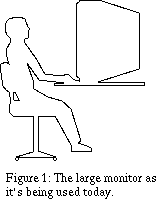 development of both large and flat displays: CRT technology is approaching laser printer resolution; flat screen technologies are making rapid strides, mostly due to the popularity of portable displays and the perceived attractiveness of a large flat screen television. Such technologies enable one to rethink the way in which electronic information is accessed.
development of both large and flat displays: CRT technology is approaching laser printer resolution; flat screen technologies are making rapid strides, mostly due to the popularity of portable displays and the perceived attractiveness of a large flat screen television. Such technologies enable one to rethink the way in which electronic information is accessed. , and new metaphors become available for interacting with the computer. See figure 2. One of these metaphors, the newspaper metaphor, is discussed in detail in this thesis.
, and new metaphors become available for interacting with the computer. See figure 2. One of these metaphors, the newspaper metaphor, is discussed in detail in this thesis.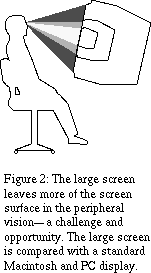 . On-line systems like Compuserve offer news from several wire services, and many newspapers provide subscription access through a modem. Some of these systems also let users specify topics of interest to offer a certain degree of personalization. Still, most people prefer to receive the paper version on the doorstep every morning instead of reading news off a screen. This project applies state-of-the-art technology to see if it is possible for an electronic newspaper to start competing with paper.
. On-line systems like Compuserve offer news from several wire services, and many newspapers provide subscription access through a modem. Some of these systems also let users specify topics of interest to offer a certain degree of personalization. Still, most people prefer to receive the paper version on the doorstep every morning instead of reading news off a screen. This project applies state-of-the-art technology to see if it is possible for an electronic newspaper to start competing with paper.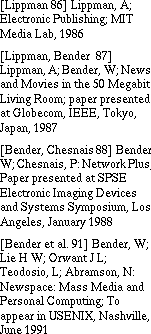 , [Lippman, Bender 87], and [Bender, Chesnais 88] and are collectively referred to as "Newspeek". The most recent project, "Newspace"--the name is borrowed from the virtual space in which articles are displayed-- is an attempt take advantage of advances in display technology to create a scalable electronic newspaper [Bender et al. 91]. The project addresses news gathering, manipulation, and presentation; The Electronic Broadsheet is an implementation of a presentation module for a large display under the Newspace project. See project outline in figure 3.
, [Lippman, Bender 87], and [Bender, Chesnais 88] and are collectively referred to as "Newspeek". The most recent project, "Newspace"--the name is borrowed from the virtual space in which articles are displayed-- is an attempt take advantage of advances in display technology to create a scalable electronic newspaper [Bender et al. 91]. The project addresses news gathering, manipulation, and presentation; The Electronic Broadsheet is an implementation of a presentation module for a large display under the Newspace project. See project outline in figure 3.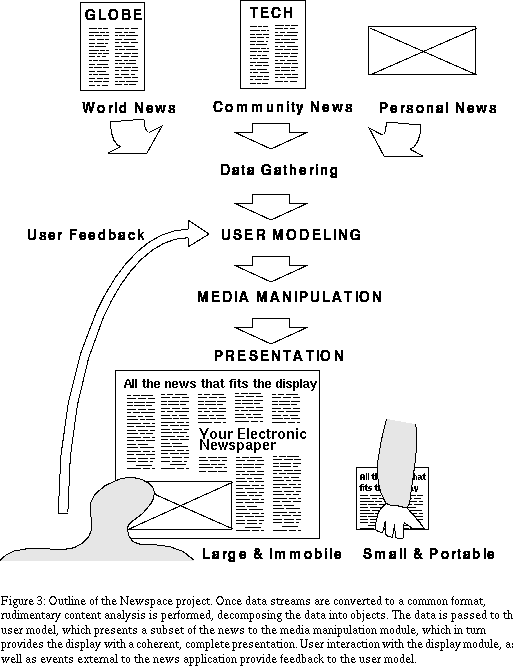
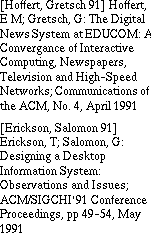 , in addition to previous Newspeek projects, have also taken news in digital form and presented it screen-based newspapers. The innovation in this project is the size and nature of the screen; I explore the impact large screens have on human-computer interaction in general and especially electronic newspapers.
, in addition to previous Newspeek projects, have also taken news in digital form and presented it screen-based newspapers. The innovation in this project is the size and nature of the screen; I explore the impact large screens have on human-computer interaction in general and especially electronic newspapers.